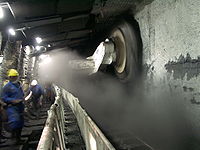
Photo from wikipedia
Deep longwall mining of coal seams is made in the Upper Silesian Coal Basin (USCB) under complicated and mostly unfavourable geological and mining conditions. Usually, it is correlated with rockburst… Click to show full abstract
Deep longwall mining of coal seams is made in the Upper Silesian Coal Basin (USCB) under complicated and mostly unfavourable geological and mining conditions. Usually, it is correlated with rockburst hazard mostly at a high level. One of the geological factors affecting the state of rockburst hazard is the presence of competent rocks in the roof of extracted coal seams, so rock falling behind the longwall face does not occur, and hanging-up of roof rocks remains. The long-lasting absence of caving may lead to an occurrence of high-energy tremor in the vicinity of the longwall face. Roof caving behind the longwall face may be forced by blasting. The column of explosives is then located in blastholes drilled in layers of roof rocks, e.g. sandstones behind the longwall face. In this article, a characterization of tremors initiated by blasts for roof caving during underground extraction of coal seam no. 507 in one of the collieries in the USCB has been made using three independent methods. By the basic seismic effect method, the effectiveness of blasting is evaluated according to the seismic energy of incited tremors and mass of explosives used. According to this method, selected blasts gave extremely good or excellent effect. An inversion of the seismic moment tensor enables determining the processes happening in the source of tremors. In the foci of provoked tremors the slip mechanism dominated or was clearly distinguished. The expected explosion had lesser significance or was not present. By the seismic source parameters analysis, among other things, an estimation of the stress drop in the focus or its size may be determined. The stress drop in the foci of provoked tremors was in the order of 10 5 Pa and the source radius, according to the Brune’s model, varied from 44.3 to 64.5 m. The results of the three mentioned methods were compared with each other and observations in situ. In all cases the roof falling was forced.
Journal Title: Pure and Applied Geophysics
Year Published: 2019
Link to full text (if available)
Share on Social Media: Sign Up to like & get
recommendations!